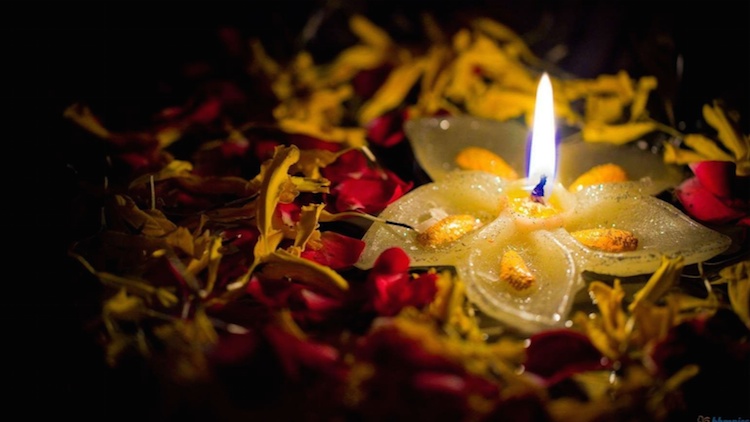A Diwali Reflection: The Exchange of Lamps
By Vineet Chander (Venkata Bhatta Das) | Oct 24, 2014

Every year on Diwali, the lighting of lamps–the diya–plays a central role in the celebration. Whether traditional oil lamps made of earthen clay, elaborate and artistically adorned candles, or even safety conscious battery-operated tea lights, the lights are ubiquitous. Ask observant Hindus why they light the diya, and you are likely to get as many explanations as there are types of candles! A practice uniting families and communities, an emblem of selfless service, a reenactment of faith and devotion expressed in bygone times–it is all of these.
I’d like to suggest, though, that one way of reflecting on the spiritual significance of the lamp on Diwali is to consider that we are evoking not one, but two lightings. Or, said another way, we are speaking of a graceful exchange of lamps–one lit by us in welcoming the Divine, and the other lit by the Divine lovingly revealing himself to us.
First, there is the offering of the lamp by the bhakta, the devotee. The epic known as the Ramayana describes how, after Rama’s triumph over the demonic Ravana, he and the goddess Sita returned to their kingdom in Ayodhya. The beloved couple had been exiled (there is an elaborate back-story here) for fourteen long years, and the citizens of the kingdom joyously anticipated their return. With this in mind, they set out rows of lamps (literally, dipavali or diwali) to light the way. Let us consider the mood in which the residents of Ayodhya lit up the kingdom for the return of their beloved Sita and Rama. They weren’t merely going through the motions. The night was amavasya, the new moon, and so the sky was dark. Undaunted, they lit lamps. At the same time, they overcame complacency and resisted the temptation to take it for granted that Sri Rama would come whether they acted or not. Surely if he could slay a demon king and liberate the island of Lanka, he could find his way home on a moonless night, they might have thought. But their love triumphed over such dry logic. Our Lord needs us to light the way for him; we must prepare for his arrival. He will be so happy to see his kingdom this way, cleaned and decorated and lit by these lamps. He will smile and accept each of these simple lamps. From the depths of their hearts, full of feeling, they lit the lamps as offerings.
Here is how one poet-saint in the Bhakti tradition describes it: if we choose to, we can learn to transform the heart into a temple, decorate that temple by cultivating humility and kindness and carefully clean it by sweeping the dust of arrogance and envy and hatred out, and within that temple offer the lamp of our love.
We can follow this example of the Ayodhya-vasis, those simple devoted citizens who lit their lamps, by being active participants in expressing our devotion. We might look at a world around us, observe hatred and suffering and selfishness, and see it as a dark moonless night. Let us develop that courage to be carriers of light; let us light lamps. Let our hearts conquer over our heads and let us think: may my heart be a temple that Sri Rama will be so happy to enter, let me clean it for Him and make it a place for Him to reside. He will smile and accept my simple offering.
The heart is the place where we keep that which we treasure the most. What might it mean to make our hearts a temple? Perhaps it means to live our lives in a way that expresses our devotion not just in religious ritual, but in every word we speak, every action we perform, and every intention we put out. Love of God, we are told, manifests in the world as compassion.
But the divine mystery is that this compassion flows in two ways, and there is a second lamp–one lit by Bhagavan, the Divine. In the Bhagavad Gita, Sri Krishna reveals this:
tesām evānukampārtham aham ajnāna-jam tamah
nāsayāma ātma-bhāva-stho jnāna-dipena bhāsvatā
“Out of compassion for those who devote themselves to Me, I – dwelling within the innermost chambers of their hearts – destroy the darkness born of ignorance, with the effulgent lamp of knowledge.” (Bg. 10.11)
Our light invites the Divine within our hearts; dwelling there, He breaks through the darkness and fills our lives with the light of understanding. His lighting this lamp for us is a pure act of grace, a gift; our lighting of lamps is an expression of our eagerness to receive this grace, and an expression of gratitude for it. Our compassion attracts the compassion of the Divine, and yet one does not wait for the other; they are part of a fluid, graceful exchange–if we want.
So this is the challenge: This year, as we conclude our festive observances of Diwali and turn to thoughts of the new year ahead; as we pack the candles and diyas away to be brought out again next Autumn; as the superficial and ephemeral aspects of the holiday season start to fade away, can we commit ourselves to this exchange of lamps? Can we make everything we put out into the world an offering of devotion, an invitation to Divinity to reside in our hearts? And can we take the time to be still, and quiet, and present enough to see and hear that Divinity when it dwells there? Undaunted by the darkness, let us try.















